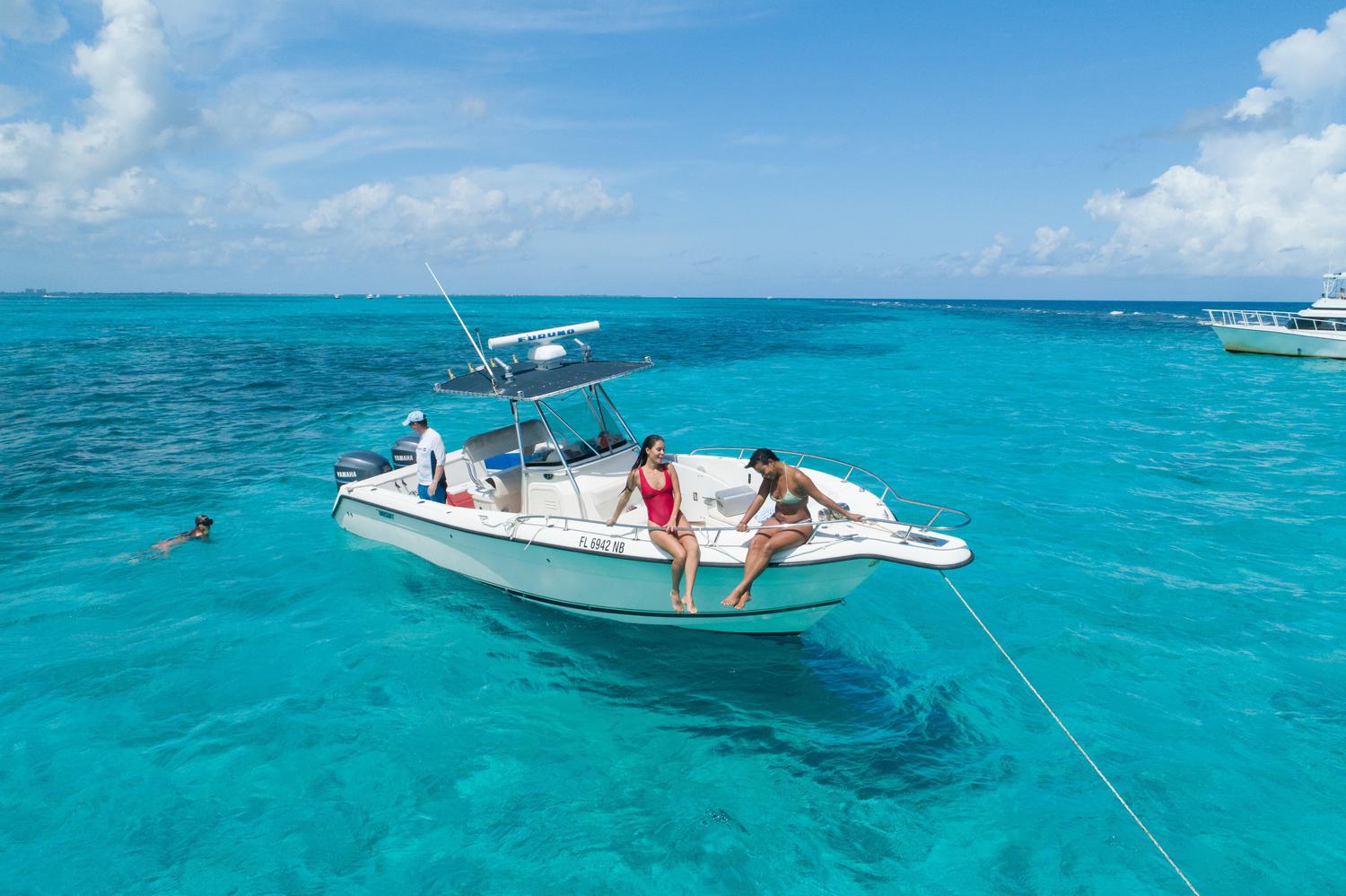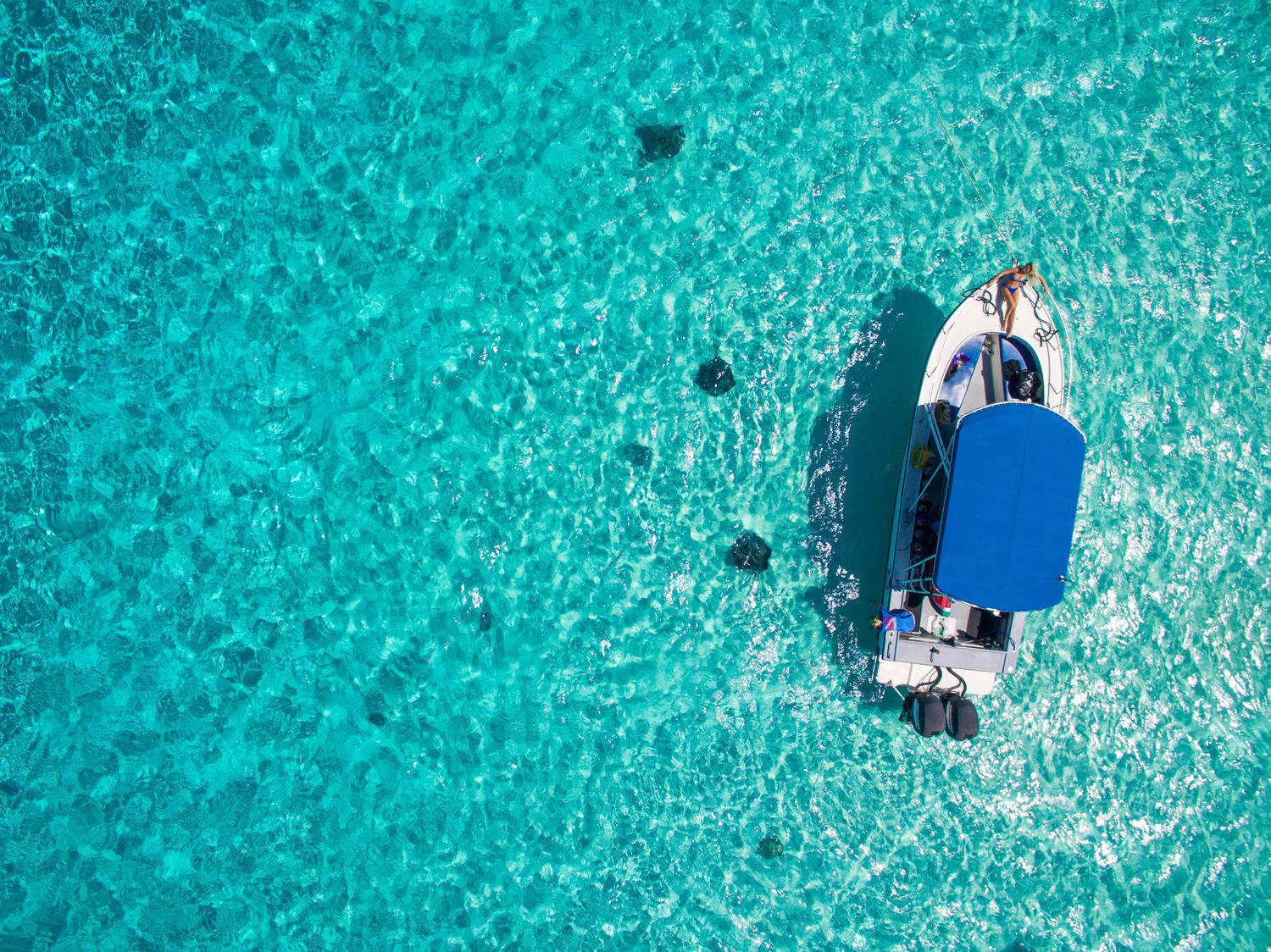Cayman has tons of great places to explore by boat! Read on to find out about some popular spots... and even some hidden boating gems. Each spot has something different to offer.
On This Page
Seven Mile Beach is mainly where you will find a lot of divers and snorkelers which makes accessing the water fairly hard. When boating to and from SMB you will need exercise caution of both coral and people.
The North Sound is the main route for boat travel. This is typically where all of the boat trips & charters are carried out since the sound is enclosed by a barrier reef that provides protection from rough weather. There are also a variety of restaurants that are accessible by water.
On the South, East and North Coasts you will find undeveloped beaches that are perfect for a family picnic or lunch, however you may need to get into the water to get onto some of these beaches as there are very few docks in this area.
Seven Mile Beach
Seven Mile Beach is typically the calmest side of the Island but does occasionally get battered by Nor’westers in the winter months and tropical storms in the summer months. Navigation is easy here because there are no barrier reefs in this area, however, the only boat ramps on Seven Mile Beach are at the Lobster Pot dock and at the beginning of Northwest Point Road in West Bay. Boaters will often anchor off of beach bars and restaurants such as those at The Westin, Ritz-Carlton and Kimpton Seafire hotels.
You can also take your boat around from the North Sound and South Sound to Seven Mile Beach, but you need to be familiar with the channels through the reef in the North Sound, have a suitable and well-maintained boat and be prepared for a slightly rougher trip outside of the reef until you get to calmer waters off Seven Mile Beach.
Currently there are no gas stations where members of the public can dock and refuel along the west side of the Island. If you are considering regularly keeping your boat in the water overnight, it is best to seek authorisation from the Department of Environment (DoE) to install a mooring. Unfortunately, even with a mooring, your vessel (and engine) is vulnerable to theft. Norwesters can occasionally make the sea very rough, and if you are not conscious of the weather conditions, your vessel could end up on the shore quickly.
Even though a number of commercial and personal vessels anchor regularly off Seven Mile Beach (and George Town) overnight, it is not advisable. It is possible that a propeller from another vessel could accidentally cut the anchor line and, if the anchor drags, the wind will take the boat offshore.
Snorkellers and divers in this area should be flying the divers down flag, however, when travelling close to shore, always be cautious. Do not exceed five knots within 600ft from the coast and do not anchor in marked boat channels, coral, diving or swimming areas. Note that beach front properties and hotels, with designated swim areas cannot be entered by any vessel.
The North Sound
There are several launching ramps that provide access in this area and most boat owners keep their boats docked in the North Sound. The Sound is enclosed by a barrier reef and has a network of canals that provide excellent protection from the weather in all but the most extreme conditions (such as a hurricane).
Theft is uncommon and a canal generally offers access to fresh water to keep the boat clean. There is also easier access to fuel stations.
The North Sound also offers excellent shallow snorkelling areas, such as Coral Gardens and the world-renowned Stingray City. North Wall diving is very good as well, but sea conditions can be rough. Beachside bars and restaurants at Rum Point and Kaibo, as well as boat hangouts at Starfish Point and the Mini Sandbar are popular stops for the boating crowd.
Some boaters also head up to Morgan’s Harbour where you'll find Calypso Grill and Tukka West. Dock space can be limited and the onshore breeze can make docking a challenge, so be careful. Just to the north of Morgan’s Harbour is an area called Barkers that offers miles of undeveloped white sand beaches and some good light tackle fishing for bonefish. Navigate carefully; it is easy to strike a coral head and damage your propeller and the coral, also watch out for kite surfers. Back down at the Cayman Islands Yacht Club, boaters can enjoy two more fantastic restaurants, Morgan’s Seafood Restaurant and Bàcaro. Both restaurants are popular with boaters and there is ample docking space. You can also take your boat into George Town Yacht Club (GTYC) or Camana Bay. At GTYC, you can enjoy lunch or dinner while the children play in the pool. Camana Bay has a well-marked entry and free sheltered docking with access to lots of restaurants and bars. Also there is plenty of depth for larger boats.
The North Sound is great for fishing and catching conch and lobster, but abide by the Marine Parks Law. Violations of the Laws can result in serious fines, confiscation of your boat or even a prison term. Ignorance of the Laws are no excuse.
Although partially enclosed by a barrier reef, the Sound can get choppy. If your boat is under 22ft long, you (and your guests) are very likely to get wet from sea spray on an average day.
The Central Mangrove Wetland is on the east side and is a protected Environmental Zone. All in-water activity, fishing and anchoring are completely prohibited, but boats can access the area provided they do not exceed five knots. People enjoy kayaking around the canal systems and also in English Bay, located east of Kaibo, as it is a great nature experience.
The Cayman Islands’ Sailing Club is located on the south-western side of the North Sound and you will often see dinghies sailing out from the club. Larger sail boats venture into the Sound, but the access through the reef is fairly shallow, so no boats with drafts greater than 10ft can enter. Watch out for areas that have shallow coral heads, such as The Blower’s, Fisherman’s Rock, Barkers, The Standards and Four-Way Reef; these areas have claimed many propellers and even some boats.
South, East and North Coasts
There are some excellent boating opportunities on the South, East and North coasts of Grand Cayman, but you will generally need a vessel that can be launched by trailer if you want to explore these more remote locations.
In some of these areas you can find miles of undeveloped beaches, great fishing, and pristine diving and snorkelling, but you may want to take a local guide with you the first few times you venture out. In these more isolated areas, it is easy for your propeller to find a coral head if you don’t know what you are doing. The first few times you venture out, you may want to accompany a local guide as it is easy for your propeller to hit a coral head if you don’t know where you are going.
Remember to always carry water, a cell phone and a working radio. The Port Authority has a list of items you must have on board (such as life jackets), depending on the size of your boat. As a general rule in the Cayman Islands, the rule of law is respected, upheld and actively enforced. It is very likely that if you are out on the water, you will be approached by a vessel operated by Marine Parks or Marine Police officers. Have fun, but be aware that penalties for breaking the rules on the water are really very serious; it is worth taking the time to pick up a copy of the Marine Parks Rules and Regulations as well as the Port Authority Law.





